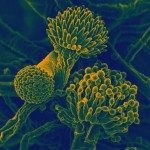Link to Pubmed [PMID] – 19692333
J. Biol. Chem. 2009 Oct;284(42):28687-97
Gram-negative binding protein 3 (GNBP3), a pattern recognition receptor that circulates in the hemolymph of Drosophila, is responsible for sensing fungal infection and triggering Toll pathway activation. Here, we report that GNBP3 N-terminal domain binds to fungi upon identifying long chains of beta-1,3-glucans in the fungal cell wall as a major ligand. Interestingly, this domain fails to interact strongly with short oligosaccharides. The crystal structure of GNBP3-Nter reveals an immunoglobulin-like fold in which the glucan binding site is masked by a loop that is highly conserved among glucan-binding proteins identified in several insect orders. Structure-based mutagenesis experiments reveal an essential role for this occluding loop in discriminating between short and long polysaccharides. The displacement of the occluding loop is necessary for binding and could explain the specificity of the interaction with long chain structured polysaccharides. This represents a novel mechanism for beta-glucan recognition.



